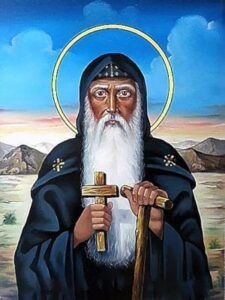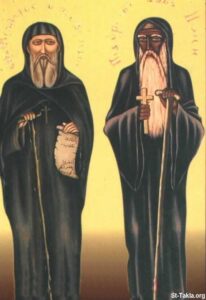St. Moses, the Strong, the Black, the Ethiopian, – Aug 28 I A Mugger to a Monk – A Sinner to a Saint

Moses, the Black, also known as Moses, the strong was an Ethiopian by race was an ascetic monk and priest, and a notable Desert Father, who lived in Egypt during the fourth century. Since He was black of skin he was called ‘Murin’ (meaning “like an Ethiopian”). He was a servant or slave to an Egyptian official. He was a man of huge stature. His master drove him out because he committed a murder. He then roamed the Nile Valley and finally joined a band of robbers. Because of his great physical strength and bad character, they chose him as their leader. Moses and his band of robbers were feared because of their many evil acts including murders and robberies. People trembled at the mere mention of his name.
Once Moses sought revenge on a man whose barking dog kept him from an intended robbery of sheep. He swam the Nile and killed four of the man’s sheep, swam back across the Nile with them. He butchered them, cooked and ate the best parts. He sold the skin for wine. Then he walked 50 miles to re-join his gang.

Moses spent several years leading a sinful life, but through the great mercy of God he repented, left his band of robbers, and went to one of the desert monasteries in the Valley Wadi al-Natrum, Skete (Scete), near Alexandria. Moses was influenced deeply, by the dedication of their lives, as well as their peace and contentment. He soon gave up his old way of life, Here he wept for a long time, begging to be admitted as one of the brethren. The monks were not convinced of the sincerity of his repentance, but the former robber would neither be driven away nor silenced. He continued to implore that they accept him.
Saint Moses was completely obedient to the hegumen (title for the head of a monastery in the Eastern Orthodox) and the brethren, and he poured forth many tears of sorrow for his sinful life. After a certain while Saint Moses withdrew to a solitary cell, where he spent his time in prayer and the strictest fasting. St. Moses was not quickly freed from the passions. He went often to the monk, Abba Isidore, seeking advice on how to be delivered from the passions of profligacy. Being experienced in the spiritual struggle, the Elder taught him never to eat too much food, to remain partly hungry while observing the strictest restraint. But the passions continued to trouble St. Moses in his dreams.
Moses was tempted by demons to get back to his old habits. Moses went to Isidore who lived in Skete and explained his conflict. He said: “What am I to do, seeing that the dreams of my soul darken my reason, by reason of my sinful habits?” He said to him: “Because you have not withdrawn your mind from imagining these things that is why you endure this. Give yourself to watching and praying with fasting and you will quickly be delivered from them.” Listening to this advice he retreated to his cell and gave his word that he would not sleep all night and not bend his knees. So, he remained in his cell for six years and every night he stood in the middle of the cell praying and not closing his eyes. And he could not master the thing. So, he suggested to himself yet another plan, and going out by night he would visit the cells of the older and more ascetic (monks) and taking their water-pots secretly would fill them with water. For they fetched their water from a distance, some from two miles off, some five miles, others half a mile.

Several accounts note how for years he struggled with temptation to return to his robber life after he had chosen the monastic way. Once, while alone in his cell, four robbers of his former band, attacked him. He had lost none of his great physical strength, He tied them up, slung them over his shoulders and took them to the church where he dumped them, declaring that it was un-Christian to harm them and inquiring what was to be done with them. He asked the Elders what to do with them. The Elders ordered that they be set free. The robbers, learning that they had chanced upon their former ringleader, and that he had dealt kindly with them, followed his example: they repented and became monks. Later, when the rest of the band of robbers heard about Saint Moses’ repentance, then they also gave up their thievery they repented and became fervent monks and joined the community.
After many years of monastic life, St Moses was ordained deacon. The bishop clothed him in white vestments and said, “Now Abba Moses is entirely white!” The saint replied, “Only outwardly, for God knows that I am still dark within.” Once, the bishop decided to test him and he directed the clergy to drive him out of the altar, insulting him as an unworthy Ethiopian. In all humility, the monk accepted the abuse.
When a brother committed a fault and Moses was invited to a meeting to discuss an appropriate penance, Moses refused to attend. When he was again called to the meeting, Moses took a leaking jug filled with water and carried it on his shoulder. Another version of the story has him carrying a basket filled with sand. When he arrived at the meeting place, the others asked why he was carrying the jug. He replied, “My sins run out behind me and I do not see them, but today I am coming to judge the errors of another.” On hearing this, the assembled brothers forgave the erring monk. Moses became the spiritual leader of a colony of hermits in the Western Desert. Later, he was ordained a priest.

Having put him to the test, the bishop of Alexandria, Mar Theophilus, then ordained St. Moses to the priesthood. St. Moses labored for fifteen years in this rank and gathered many disciples around him.
When the saint reached the age of 75, he warned his monks that soon robbers would descend upon Skete and murder all those who remained there. The saint asked his monks to leave, in order to avoid violent death. His disciples begged the saint to leave with them, but he replied: “For many years now, I have awaited the time when the words of my Master, the Lord Jesus Christ, should be fulfilled: ‘All who take up the sword, shall perish by the sword” (Matt. 26: 52). After this, seven of the brethren remained with St. Moses, and one of them hid nearby during the attack of the robbers. The robbers killed St. Moses and the six monks who remained with him. Moses was entombed at the monastery called Dair al-Baramus. This occurred about the year 400.
Moses was highly praised by his contemporaries. In his 5th century AD Ecclesiastical History, written about 70 years after Moses’s death, Hermias Sozomen sums up Moses’s legacy as follows: “So sudden a conversion from vice to virtue was never before witnessed, nor such rapid attainments in monastical philosophy”. Hence God rendered him an object of dread to the demons and he was ordained presbyter over the monks at Scetis. After a life spent in this manner, he died at the age of seventy-five, leaving behind him numerous eminent disciples.
The feast of St. Moses, the Black is celebrated in the Orthodox Syrian Church on 18 June and 28 August. Moses the Ethiopian is honoured as an apostle of non-violence. His relics and major shrine were found at the Church of the Virgin Mary in the Coptic Orthodox monastery, Paromeos Monastery located in Wadi El Natrun.

0 Comments